Name Omar Khayyam | ||
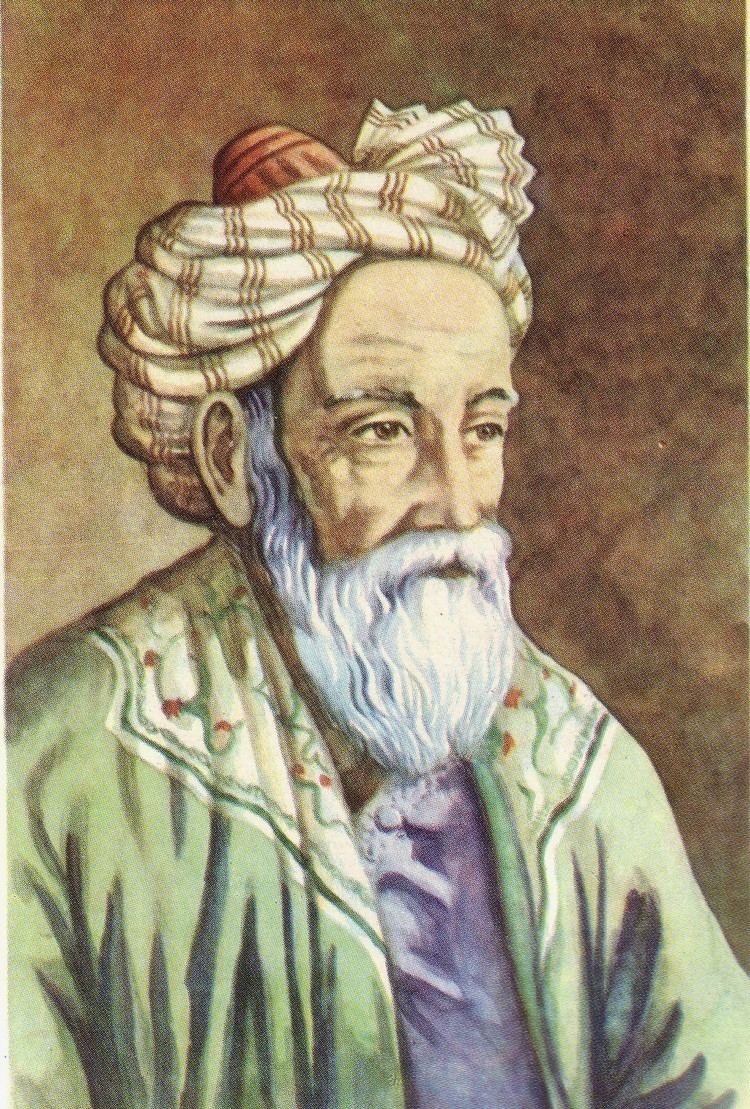 | ||
Books Rubaiyat of Omar Khayyam, Come Fill the Cup [sound R, An Essay by the Uniquely, The little book of The rubai, The nectar of grace Similar People | ||
Schools of thought Iranian philosophy | ||
Iran persia omar khayyam the poet of uncertainty 1 of 5 bbc culture documentary
Omar Khayyam ([xæjˈjɑːm]; full name Ġiyāṯ al-Dīn Abu l-Fatḥ ʿUmar ibn Ibrāhīm Al-Naysābūrī al-Khayyāmī; 18 May 1048 – 4 December 1131) was a Persian mathematician and astronomer-astrologer. As a scholar, he is most notable for his work on cubic equations and his calendar reform. Omar was born in Nishapur, in northeastern Iran. He moved to Samarkand at a young age and obtained his education there. Afterwards he moved to Bukhara and became established as one of the major mathematicians and astronomers of the Islamic Golden Age. His treatise on algebra (Maqāla fi l-jabr wa l-muqābala) includes a geometric method for solving cubic equations by intersecting a hyperbola with a circle. For decades, he also taught the philosophy of Avicenna in Nishapur.
Contents
- Iran persia omar khayyam the poet of uncertainty 1 of 5 bbc culture documentary
- Famousmathprobs 5 omar khayyam and the binomial theorem
- Life
- Mathematics
- Theory of parallels
- Geometric algebra
- Binomial theorem and extraction of roots
- Astronomy
- Calendar reform
- Poetry
- Philosophy
- Mathematical philosophy
- Skepticism vs Sufism
- Reception
- References
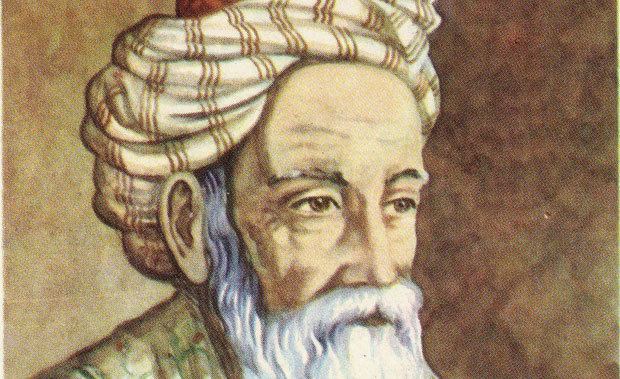
There is a tradition of attributing poetry to Omar Khayyam, written in the form of quatrains (rubāʿiyāt رباعیات). This poetry became widely known due to the English translation by Edward FitzGerald (Rubaiyat of Omar Khayyam, 1859), which enjoyed great success in the Orientalism of the fin de siècle.
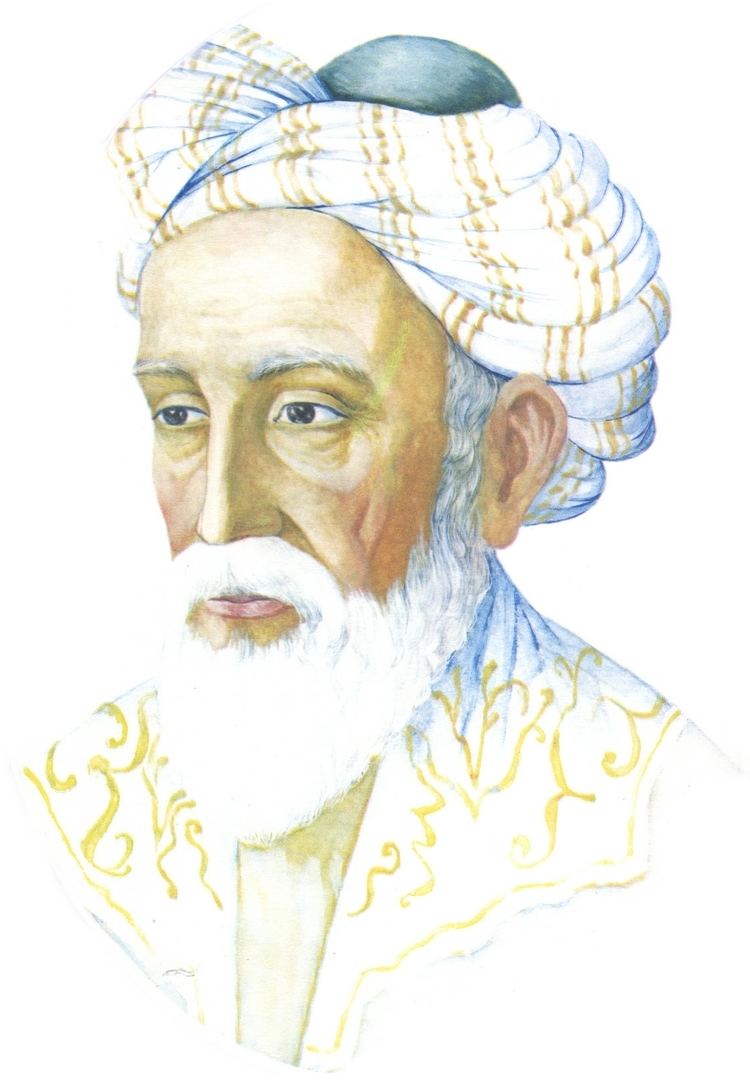
Famousmathprobs 5 omar khayyam and the binomial theorem
Life
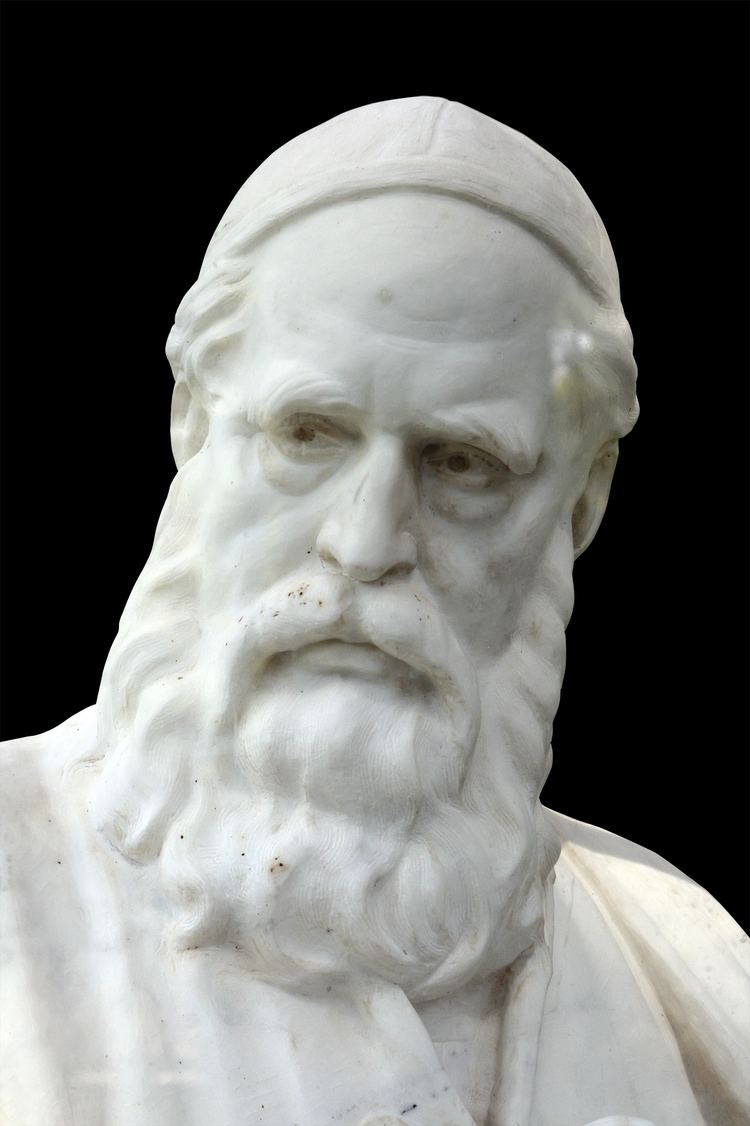
Omar Khayyam was born in Nishapur, a metropolis in Khorasan that was destroyed by the Mongols in 1220. Nishapur was then a Seljuq capital and it was religiously a major center of Zoroastrians. It is likely that Khayyam's father was a Zoroastrian who had converted to Islam. He was born into a family of tent-makers (Khayyam).
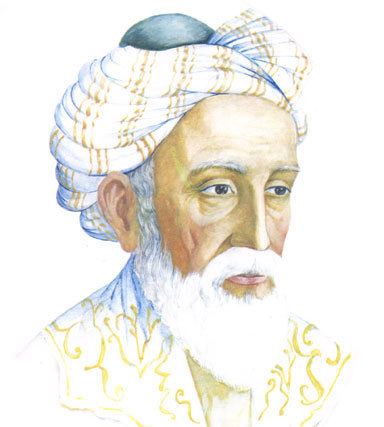
He spent part of his childhood in the town of Balkh (in present-day northern Afghanistan), studying under the scholar Sheikh Muhammad Mansuri. He later studied under Imam Mowaffaq Nishapuri, one of the greatest teachers of the Khorasan region. Throughout his life, Omar Khayyam taught algebra and geometry during the day, and in the evening attended the Seljuq court as an adviser of Malik-Shah I. At night he studied astronomy and worked on the Jalali calendar.
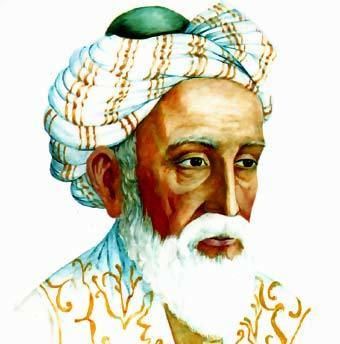
Khayyam's years in Isfahan were productive, but after the death of the Seljuq Sultan Malik-Shah I (presumably by the Assassins' sect), the Sultan's widow turned against him as an adviser, and as a result, he soon set out on his Hajj or pilgrimage to Mecca and Medina. He was then allowed to work as a court astrologer, and to return to Nishapur. Khayyam died in 1131, and is buried in the Khayyam Garden in Nishapur.
Mathematics
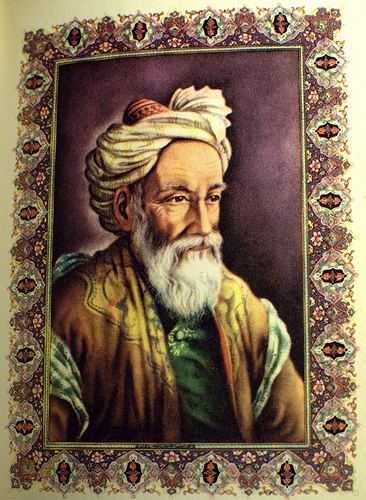
Khayyam was famous during his life as a mathematician. Three of his treatises are extant: A commentry on Euclid's Elements (Risāla fī šarḥ mā aškala min muṣādarāt kitāb Uqlīdis, completed 1077), an essay on dividing the quadrant of a circle, and a treatise on algebra (Maqāla fi l-jabr wa l-muqābala). He furthermore wrote a treatise on extracting the nth root of natural numbers, which has been lost.
The treatise on algebra contains his work on cubic equations. It is divided into three parts, (a) equations which can be solved with ruler and compass, (b) equations which can be solved by means of conic sections, and (c) equations which involve the inverse of the unknown.
In the Treatise, he wrote on the triangular array of binomial coefficients known as Pascal's triangle. In 1077, Khayyam wrote Sharh ma ashkala min musadarat kitab Uqlidis (Explanations of the Difficulties in the Postulates of Euclid) published in English as "On the Difficulties of Euclid's Definitions". An important part of the book is concerned with Euclid's famous parallel postulate, which attracted the interest of Thabit ibn Qurra. Al-Haytham had previously attempted a demonstration of the postulate; Khayyam's attempt was a distinct advance, and his criticisms made their way to Europe, and may have contributed to the eventual development of non-Euclidean geometry.
Khayyam wrote on geometry, specifically on the theory of proportions.
Theory of parallels
Khayyam wrote Explanations of the difficulties in the postulates in Euclid's Elements. The book consists of several sections on the parallel postulate (Book I), on the Euclidean definition of ratios and the Anthyphairetic ratio (modern continued fractions) (Book II), and on the multiplication of ratios (Book III).
The first section is a treatise containing some propositions and lemmas concerning the parallel postulate. It has reached the Western world from a reproduction in a manuscript written in 1387–88 by the Persian mathematician Tusi. Tusi mentions explicitly that he re-writes the treatise "in Khayyam's own words" and quotes Khayyam, saying that "they are worth adding to Euclid's Elements (first book) after Proposition 28." This proposition states a condition enough for having two lines in plane parallel to one another. After this proposition follows another, numbered 29, which is converse to the previous one. The proof of Euclid uses the so-called parallel postulate (numbered 5). Objection to the use of parallel postulate and alternative view of proposition 29 have been a major problem in foundation of what is now called non-Euclidean geometry.
The treatise of Khayyam can be considered the first treatment of the parallels axiom not based on petitio principii, but on a more intuitive postulate. Khayyam refutes the previous attempts by other Greek and Persian mathematicians to prove the proposition. And he, as Aristotle, refuses the use of motion in geometry and therefore dismisses the different attempt by Ibn Haytham, too. In a sense he made the first attempt at formulating a non-Euclidean postulate as an alternative to the parallel postulate,
Khayyam illustrated Euclid's parallel postulate in Book I of Explanations of the Difficulties in the Postulates of Euclid. Khayyam was not trying to prove the parallel postulate as such but to derive it from an equivalent postulate he formulated from "the principles of the Philosopher" (Aristotle):
Two convergent straight lines intersect and it is impossible for two convergent straight lines to diverge in the direction in which they converge.Khayyam then considered the three cases (right, obtuse and acute) that the summit angles of a Saccheri quadrilateral can take and after proving a number of theorems about them, he (correctly) refuted the obtuse and acute cases based on his postulate and hence derived the classic postulate of Euclid.
Geometric algebra
This philosophical view of mathematics (see below) has influenced Khayyam's celebrated approach and method in geometric algebra and in particular in solving cubic equations. His solution is not a direct path to a numerical solution, and his solutions are not numbers but line segments. Khayyam's work can be considered the first systematic study and the first exact method of solving cubic equations, although similar methods had appeared sporadically since Menaechmus.
In work on cubic equations by Khayyam discovered in the 20th century, where the above quote appears, Khayyam works on problems of geometric algebra. First is the problem of "finding a point on a quadrant of a circle such that when a normal is dropped from the point to one of the bounding radii, the ratio of the normal's length to that of the radius equals the ratio of the segments determined by the foot of the normal." Again in solving this problem, he reduces it to another geometric problem: "find a right triangle having the property that the hypotenuse equals the sum of one leg (i.e. side) plus the altitude on the hypotenuse ". To solve this geometric problem, he specializes a parameter and reaches the cubic equation x3 + 2x = 2x2 + 2. Indeed, he finds a positive root for this equation by intersecting a hyperbola with a circle.
This particular geometric solution of cubic equations has been further investigated and extended to degree four equations.
Regarding more general equations he states that the solution of cubic equations requires the use of conic sections and that it cannot be solved by ruler and compass methods. A proof of this impossibility was only plausible 750 years after Khayyam died. In this text Khayyam mentions his will to prepare a paper giving full solution to cubic equations: "If the opportunity arises and I can succeed, I shall give all these fourteen forms with all their branches and cases, and how to distinguish whatever is possible or impossible so that a paper, containing elements which are greatly useful in this art, will be prepared."
This refers to the book Treatise on Demonstrations of Problems of Algebra (1070), which laid down the principles of algebra, part of the body of Persian mathematics that was eventually transmitted to Europe. In particular, he derived general methods for solving cubic equations and even some higher orders.
Binomial theorem and extraction of roots
This particular remark of Khayyam and certain propositions found in his Algebra book have made some historians of mathematics believe that Khayyam had indeed a binomial theorem up to any power. The case of power 2 is explicitly stated in Euclid's elements and the case of at most power 3 had been established by Indian mathematicians. Khayyam was the mathematician who noticed the importance of a general binomial theorem. The argument supporting the claim that Khayyam had a general binomial theorem is based on his ability to extract roots.
Astronomy
Like most Persian mathematicians of the period, Khayyam was also an astronomer and achieved fame in that role, especially for his expertise in horoscopic astrology. In 1073, the Seljuq Sultan Jalal al-Din Malik-Shah Saljuqi (Malik-Shah I, 1072–92), invited Khayyam to build an observatory, along with various other distinguished scientists. According to some accounts, the version of the medieval Iranian calendar in which 2,820 solar years together contain 1,029,983 days (or 683 leap years, for an average year length of 365.24219858156 days) was based on the measurements of Khayyam and his colleagues. Another proposal is that Khayyam's calendar simply contained eight leap days every thirty-three years (for a year length of 365.2424 days). In either case, his calendar was more accurate to the mean tropical year than the Gregorian calendar of 500 years later. The modern Iranian calendar is based on his calculations.
A popular claim to the effect that Khayyam believed in heliocentrism is based on Edward FitzGerald's popular but anachronistic rendering of Khayyam's poetry, in which the first lines are mistranslated with a heliocentric image of the Sun flinging "the Stone that puts the Stars to Flight".
Calendar reform
Khayyam was a member of a panel that reformed the Iranian calendar. The panel was convened by Seljuk Sultan Malik Shah I, and completed its reforms in 1079, resulting in the Jalali calendar.
While the Jalali calendar is more accurate than the Gregorian, it is based on actual solar transit, similar to Hindu calendars, and requires an ephemeris for calculating dates. The lengths of the months can vary between 29 and 31 days depending on the moment when the sun crosses into a new zodiacal area (an attribute common to most Hindu calendars). This meant that seasonal errors were lower than in the Gregorian calendar.
The Jalali calendar remained in use across Greater Iran from the 11th to the 20th centuries. In 1911 the Jalali calendar became the official national calendar of Qajar Iran. In 1925 this calendar was simplified and the names of the months were modernised, resulting in the modern Iranian calendar.
Poetry
There is a manuscript tradition attributing poetry, mostly in the form of quatrains (rubaiyat) to Omar Khayyam. There are more than 100 manuscripts containing such poetry, but all of them are comparatively late, the earliest such source that can be dated with confidence was written in 1460, and the bulk dates to the 17th to 19th centuries. Bodleian MS. Ouseley 140, a manuscript written in Shiraz in 1460, contains 158 quatrains on 47 folia. The manuscript belonged to William Ouseley (1767-1842) and was purchased by the Bodleian Library in 1844.
There are occasional quotes of verses attributed to Omar in texts attributed to authors of the 13th and 14th centuries, but these are also of doubtful authenticity, so that skeptic scholars point out that the entire tradition may be pseudepigraphic. Hans Heinrich Schaeder in 1934 commented that the name of Omar Khayyam "is to be struck out from the history of Persian literature" due to the lack of any material that could confidently be attributed to him. De Blois (2004) presents a bibliography of the manuscript tradition, concluding pessimistically that the situation has not changed significantly since Schaeder's time. Five of the quatrains later attributed to Omar are found as early as 30 years after his death, quoted in Sindbad-Nameh. While this establishes that these specific verses were in circulation in Omar's time or shortly later, it doesn't imply that the verses must be his. De Blois concludes that at the least the process of attributing poetry to Omar Khayyam appears to have begun already in the 13th century.
However, the poetry attributed to Omar Khayyam has contributed greatly to his popular fame in the modern period as a direct result of the extreme popularity of the translation of such verses into English by Edward FitzGerald (1859). FitzGerald's Rubaiyat of Omar Khayyam contains loose translations of quatrains from The Bodleian manuscript. It enjoyed such success in the fin de siécle period that a bibliography compiled in 1929 listed more than 300 separate editions, and many more have been published since.
Philosophy
Khayyam himself rejected any association with the title falsafī "philosopher" in the sense of Aristotelianism and stressed he wishes "to know who I am". In the context of philosophers he was labeled by some of his contemporaries as "detached from divine blessings".
Khayyam for decades taught the philosophy of Avicena, especially the Book of Healing, in his home town Nishapur, till his death. In an incident he had been requested to comment on a disagreement between Avicena and a philosopher called Abu'l-Barakāt al-Baghdādī who had criticized Avicena strongly. Khayyam is said to have answered "[he] does not even understand the sense of the words of Avicenna, how can he oppose what he does not know?"
Khayyam's popularity in the West is closely associated with the reception of his poetry as extolling wine and praising a life of mystic ecstasy and hedonism. This reception also became prevalent in modern Iran, where nightclubs are named after Khayyam. Sadegh Hedayat portrayed Khayyam as "a materialist, pessimist, agnostic", who "looked at all religions' questions with a skeptical eye". Conversely, Khayyam has also been described as a mystical Sufi poet.
Mathematical philosophy
As a mathematician, Khayyam has made fundamental contributions to the philosophy of mathematics especially in the context of Persian Mathematics and Persian philosophy with which most of the other Persian scientists and philosophers such as Avicenna, Abū Rayḥān al-Bīrūnī and Tusi are associated. There are at least three basic mathematical ideas of strong philosophical dimensions that can be associated with Khayyam.
- Mathematical order: From where does this order issue, and why does it correspond to the world of nature? His answer is in one of his philosophical "treatises on being". Khayyam's answer is that "the Divine Origin of all existence not only emanates wujud "being", by virtue of which all things gain reality, but It is the source of order that is inseparable from the very act of existence."
- The significance of axioms in geometry and the necessity for the mathematician to rely upon philosophy and hence the importance of the relation of any particular science to prime philosophy. This is the philosophical background to Khayyam's total rejection of any attempt to "prove" the parallel postulate, and in turn his refusal to bring motion into the attempt to prove this postulate, as had Ibn al-Haytham, because Khayyam associated motion with the world of matter, and wanted to keep it away from the purely intelligible and immaterial world of geometry.
- Clear distinction made by Khayyam, on the basis of the work of earlier Persian philosophers such as Avicenna, between natural bodies and mathematical bodies. The first is defined as a body that is in the category of substance and that stands by itself, and hence a subject of natural sciences, while the second, called "volume", is of the category of accidents (attributes) that do not subsist by themselves in the external world and hence is the concern of mathematics. Khayyam was very careful to respect the boundaries of each discipline, and criticized Ibn al-Haytham in his proof of the parallel postulate precisely because he had broken this rule and had brought a subject belonging to natural philosophy, that is, motion, which belongs to natural bodies, into the domain of geometry, which deals with mathematical bodies.
Skepticism vs. Sufism
Sadegh Hedayat is the most notable proponent of Khayyam's philosophy as agnostic skepticism. According to Jan Rypka, Hedayat even considered Khayyam an atheist. Hedayat states in his introductory essay to his second edition of the Quatrains of the Philosopher Omar Khayyam that "while Khayyam believes in the transmutation and transformation of the human body, he does not believe in a separate soul; if we are lucky, our bodily particles would be used in the making of a jug of wine". He further maintains that Khayyam's usage of Sufic terminology such as "wine" is literal, and that "Khayyam took refuge in wine to ward off bitterness and to blunt the cutting edge of his thoughts."
Edward FitzGerald emphasized the religious skepticism he found in Omar Khayyam. In his preface to the Rubáiyát, he describes Omar's philosophy as Epicurean and claims that Omar was "hated and dreaded by the Sufis, whose practice he ridiculed and whose faith amounts to little more than his own, when stripped of the Mysticism and formal recognition of Islamism under which Omar would not hide."
Al-Qifti (ca. 1172–1248) appears to confirm this view of Omar's philsophy. In his work The History of Learned Men he reports that Omar's poems were only outwardly in the Sufi style, but were written with an anti-religious agenda. Mohammad Ali Foroughi concluded that Khayyam's ideas may have been consistent with that of Sufis at times but there is no evidence that he was formally a Sufi. Aminrazavi (2007) states that "Sufi interpretation of Khayyam is possible only by reading into his Rubaiyat extensively and by stretching the content to fit the classical Sufi doctrine". In this tradition, Omar's poetry has been cited in the context of New Atheism, e.g. in The Portable Atheist by Christopher Hitchens.
Other commentators do not accept that Omar's poetry has an anti-religious agenda and interpret his references to wine and drunkenness in the conventional metaphorical sense common in Sufism. Seyyed Hossein Nasr argues that it is "reductive" to use a literal interpretation of his verses (many of which are of uncertain authenticity to begin with) to establish Omar's philosophy. Instead, he adduces his work Al-Khutbat al-gharrå˘" ("The Splendid Sermon"), where Omar expresses orthodox views on Divine Unity in agreement with Avicenna. Omar's most important single work on philosophy is al-Risālah fil-wujūd (الرسالة في الوجود ("Treatise on Being"), which is explicitly theistic, citing Quranic verses and asserting that all things come from God and that there is an order to all things. In his book On the elaboration of the problems concerning the book of Euclid, Omar also praises a compassionate God and refers to "the master of prophets, Muhammad, and his pure companions."
The view of Omar Khayyam as a Sufi was defended by Bjerregaard (1915). Dougan (1991) likewise attributes the reputation of hedonism to the failings of FitzGerald's translation, arguing that Omar's poetry is to be understood as "deeply esoteric". Idries Shah (1999) similarly accuses FitzGerald of misunderstanding Omar's poetry.
The question remains somewhat open. It is clear that Omar imitates the style of the Sufi, but it is a matter of debate whether he was himself writing mystical poetry or to what extent he was (as claimed by Al-Qifti) satirizing Sufi mysticism or using it as cover for his unorthodox views. Edward Henry Whinfield (2000) concludes that "we must not run away with the idea that he was himself a Sufi."
Reception
Omar Khayyam was held in very high esteem by his contemporaries. He was primarily venerated as a scholar and scientist, according to contemporary anecdotes primarily for his expertise in horoscopic astrology. It was not unusual for him to be given flowery epithets such as "Proof of Truth", "Philosopher of the World", "Lord of the Wise Men of East and West". Shahrazuri (d. 1300) calls him "Successor to Avicenna", and Al-Qifti (d. 1248) even though disagreeing with his views concedes he was "unrivalled in his knowledge of natural philosophy and astronomy". Al-Zamakhshari (d. 1143/4) calls him "Sage of the World" or "Philosopher of the Universe".
The first non-Persian scholar to study Omar Khayyam was the English orientalist Thomas Hyde, who in his Historia religionis veterum Persarum eorumque magorum (1700) translated some of his verses into Latin. Western interest in Persia increased with the Orientalism movement in the 19th century. Joseph von Hammer-Purgstall (1774-1856) translated some of Khayyam's poems into German in 1818, and Gore Ouseley (1770-1844) into English in 1846, but Khayyam remained relatively unknown in the West until after the publication of Edward FitzGerald's Rubaiyat of Omar Khayyam in 1859. FitzGerald's work at first was unsuccessful, but was popularised by Whitley Stokes from 1861 onward, and the work came to be greatly admired by the Pre-Raphaelites. In 1872 FitzGerald had a third edition printed which increased interest in the work in America. By the 1880s, the book was extremely well known throughout the English-speaking world, to the extent of the formation of numerous "Omar Khayyam Clubs" and a "fin de siècle cult of the Rubaiyat"
FitzGerald rendered Omar's name as "Tentmaker", and the anglicized name of "Omar the Tentmaker" resonated in English-speaking popular culture for a while. Thus, Nathan Haskell Dole published a novel called Omar, the Tentmaker: A Romance of Old Persia in 1898. Omar the Tentmaker of Naishapur is a historical novel by John Smith Clarke, published in 1910. "Omar the Tentmaker" is also the title of a 1914 play by Richard Walton Tully in an oriental setting, adapted as a silent film in 1922. US General Omar Bradley was given the nickname "Omar the Tent-Maker" in World War II. The name has also been recorded as a slang expression for "penis".
Omar Khayyam's poems have been translated into many languages, many of the more recent ones more literal than the 1850s translation by FitzGerald.
FitzGerald's translations also reintroduced Khayyam to Iranians, "who had long ignored the Neishapouri poet". Sadeq Hedayat in his Songs of Khayyam (Taranehha-ye Khayyam, 1934) first introduced Omar's poetry to modern Iran, and under the Pahlavi dynasty, he was shaped into one of Iran's national icons along with Hafez, Saadi, Avicenna and others. The Mausoleum of Omar Khayyam was reconstructed under Reza Shah, by architect Hooshang Seyhoun, completed in 1963. A statue by Abolhassan Sadighi was erected in Laleh Park, Tehran in the 1960s. A bust by the same sculptor was erected near Khayyam's mausoleum in Nishapur.
A lunar crater Omar Khayyam was named after him in 1970 and a minor planet called 3095 Omarkhayyam, discovered by Soviet astronomer Lyudmila Zhuravlyova in 1980, is named after him.
In 2009, the state of Iran donated a pavilion to the United Nations Office in Vienna, erected at Vienna International Center. The pavilion includes four statues of medieval Persian scholars, one of Omar Khayyam alongside statues of Avicenna, Abu Rayhan Biruni, Zakariya Razi. In 2016, three statues of Khayyam was by Iranian sculptor Hossein Fakhimi were unveiled: one at the University of Oklahoma, one in Nishapur and one to in Florence, Italy.
